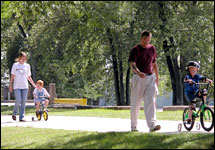MLUI / Articles from 1995 to 2012 / Getting There Together
Getting There Together
 | |
| MLUI/Carol Blundy | |
Like smooth roads and convenient transit, sidewalks and bike paths are essential building blocks of a successful transportation system. |
Citizens from every walk of life want a more balanced, cost effective, and environmentally friendly transportation system serving the Grand Valley metropolitan region. But hoping that uncongested streets, wider bike routes, safer sidewalks, and modern transit will simply appear is not enough. Citizens must get involved, work together, and push their local and state officials and elected leaders to change longstanding policies that favor cars to the near-exclusion of other ways of getting around.
The metropolitan area has a rich planning history and a wealth of transit-related expertise. Some examples:
- The Citizens League of Grand Rapids called for innovative public funding strategies to support public transit and recommended including bike paths and sidewalks in road construction projects in their April 1990 Down the Road report.
- The Grand Valley Metro Council, the regional planning organization, said compact, mixed-use development was essential to stimulate public transit in their 1998 Long Range Public Transportation Plan.
- The West Michigan Environmental Action Council proposed several light-rail options for the metropolitan area in 2000.
- The City of Grand Rapids Master Plan, adopted in 2002, calls for transit-oriented development throughout the city.
- Kent County’s Emergency Needs Task Force Transportation Subcommittee has recommended coordinating and streamlining existing transit services since 2003.
- The Creating Communities for a Lifetime initiative called for expanding transportation options for senior citizens in 2005.
These and other important efforts point the way toward developing a world-class transportation system serving the Grand Valley region. But so far, little has happened.
To change that, citizens should concentrate their efforts on three key areas.
First, we must make sure public transit administrators continue to advance new proposals to expand and enhance service in the metropolitan area. Second, we must make sure local officials encourage—and invest public dollars in— development that enables transit to flourish. Third, we must make sure state and regional leaders transform our narrowly focused and outdated state transportation funding strategy into one that provides citizens with more transportation choices. This includes ensuring that money intended for transit goes to transit, as well as finding new money to support expanded service.
This Citizens’ Agenda builds on many years of far-reaching work, sets forth a unified vision for transit, and prioritizes key action steps to achieve it. The overarching goal is to focus on, and engage you and your neighbors in, convincing our leaders to act now. You can help advance the recommendations of Getting There Together by contacting one of the following six participating civic groups:
Concerned Citizens for Improved Transit
Phone: 616-949-1100 ext. 255
www.disabilityadvocates.us/CCIT%20meetings.htm
Faith In Motion
Phone: 616-774-9037
Web: www.graceoffice.org/fim
Grand Rapids Area Chamber of Commerce
Phone: 616-771-0359
Web: www.grandrapids.org/advocacy/transportation-forum.htm
Kent County Emergency Needs Task Force Transportation Subcommittee
Phone: 616-949-1100 ext. 228
Web: www.accesskent.com/entf
Michigan Land Use Institute
Phone: 616-308-6250
Web: www.mlui.org
United Growth for Kent County
Phone: 616-336-3265
Web: www.msue.msu.edu/unitedgrowth
Sources
Down the Road…The Future of Public Transportation in the Greater Grand Rapids Area. Citizens League of Greater Grand Rapids. April 1990.
The Long Range Public Transportation Plan for the Grand Valley Region. Mobile Metro 2020 Task Force. March 1998. www.gvmc.org/transportation/longrangeplan.shtml
The Common Framework: West Michigan. A Region in Transition. West Michigan Strategic Alliance. 2002.
www.wm-alliance.org/Brix?pageID=26
City of Grand Rapids Master Plan. December 2002. www.grand-rapids.mi.us/index.pl?page_id=632
Michigan’s Land, Michigan’s Future: The Final Report of the Michigan Land Use Leadership Council. August 2003. www.michiganlanduse.org/finalreport.htm
FY 2003 to FY 2007 Short Range Public Transportation Plan. Interurban Transit Partnership.
2005-2009 Five Year Transportation Program. Michigan Department of Transportation. January 2005. http://www.michigan.gov/documents/MDOT_5_year_plan_
2006-2010_143118_7.pdf
Today’s Winners—Tomorrow’s Losers: How Urban, Suburban and Rural Areas of Greater Grand Rapids are Being Threatened by Urban Sprawl. Frey Foundation. April 1997.
Kent County Emergency Needs Task Force Report 2004-05 Update.
www.accesskent.com/YourGovernment/Publications/kcentf.htm
Creating Communities of Support for Kent County’s Aging Population. Grand Rapids Community Foundation and Grand Valley State University’s Community Research Institute. December 2002. www.cridata.org/publications/pdfs/aging_population.pdf





